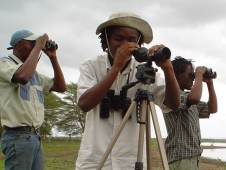
Many of the sites important for birds and other biodiversity have little or no protection, and are in a poor state and subject to high pressures
Protected area networks are vital for conservation, but have many gaps View case study list
View case study list
Many nations have extensive systems of protected areas which form on some of the most valuable means of biodiversity conservation. Although the global protected area network is hugely important—over 100,000 areas covering more than 10% of the world’s land surface are under some kind of designation—analysis has shown there are still serious gaps in coverage, with globally significant biodiversity sometimes entirely unprotected. Important Bird Areas (IBAs) make a crucial contribution to identifying exactly where the gaps are in the protected area system. A high proportion of IBAs remain unprotected, including many which hold globally threatened birds (![]() ,
, ![]() ) and these are therefore priorities for appropriate forms of statutory recognition and protection. The IBA Protection Index helps to track trends in the designation of protected areas that are important for biodiversity (
) and these are therefore priorities for appropriate forms of statutory recognition and protection. The IBA Protection Index helps to track trends in the designation of protected areas that are important for biodiversity (![]() ), though much remains to be done for the more comprehensive protection of IBAs and marine IBAs (
), though much remains to be done for the more comprehensive protection of IBAs and marine IBAs (![]() ).
).
Many IBAs are in danger View case study list
View case study list
Monitoring data reveal that many IBAs are in danger of losing their natural habitats and key biodiversity. BirdLife has launched a new initiative to identify those at severe risk (![]() ,
, ![]() ) in order to target enhanced conservation effort for these sites through advocacy, campaigning and local action. Further data have shown that IBAs with wetlands are particularly at risk (
) in order to target enhanced conservation effort for these sites through advocacy, campaigning and local action. Further data have shown that IBAs with wetlands are particularly at risk (![]() ), and efforts by partners are being made to preserve threatened IBAs worldwide (
), and efforts by partners are being made to preserve threatened IBAs worldwide (![]() ,
, ![]() ,
, ![]() ). IBAs with woodland are increasingly threatened by unsustainable forestry practices (
). IBAs with woodland are increasingly threatened by unsustainable forestry practices (![]() ,
, ![]() ), and many more face wide ranges of threats, from marine pollution (
), and many more face wide ranges of threats, from marine pollution (![]() ) to politics (
) to politics (![]() ).
).